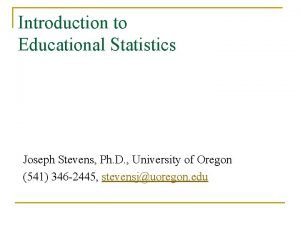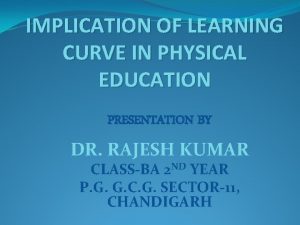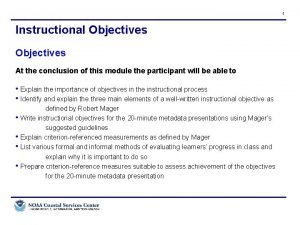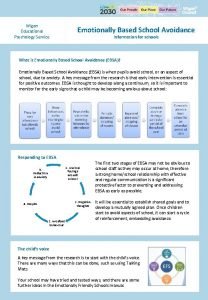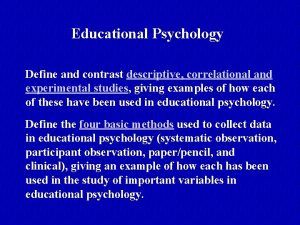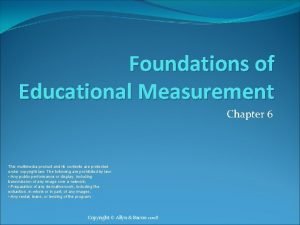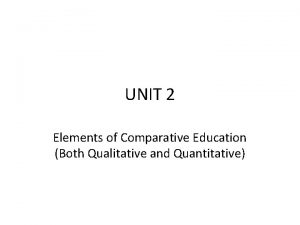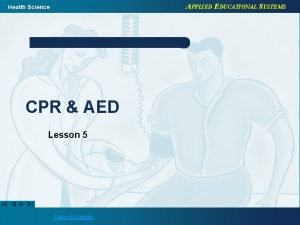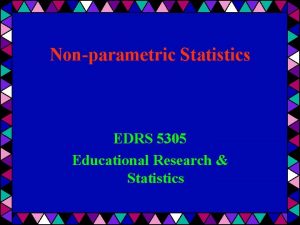Educational statistics 1 1 What is Statistics Statistics








![Substituting the values in the formula: � Median = L + [N/2 –Cumfb] x Substituting the values in the formula: � Median = L + [N/2 –Cumfb] x](https://slidetodoc.com/presentation_image_h2/4150b7857b5cd441663757f4ec90dc2b/image-9.jpg)
![�Median = 19. 5 + [ 50/2 – 21 ] x 5 � � �Median = 19. 5 + [ 50/2 – 21 ] x 5 � �](https://slidetodoc.com/presentation_image_h2/4150b7857b5cd441663757f4ec90dc2b/image-10.jpg)

























- Slides: 35

Educational statistics

1. 1: What is Statistics? Statistics: The science of collecting, describing, and interpreting data. Two areas of statistics: Descriptive Statistics: collection, presentation, and description of sample data. Inferential Statistics: making decisions and drawing conclusions about populations.

Example: A college principal is interested in learning about the average of faculty. Identify the basic terms in this situation. The population is the age of all faculty members at the college. A sample is any subset of that population. For example, we might select 10 faculty members and determine their age. The variable is the “age” of each faculty member. One data would be the age of a specific faculty member. The data would be the set of values in the sample. The experiment would be the method used to select the ages forming the sample and determining the actual age of each faculty member in the sample. The parameter of interest is the “average” age of all faculty at the college. The statistic is the “average” age for all faculty in the sample.

Calculation of Mean (long method) Class Interval (CI) Mid-Point (X) Frequency (f) 45 -49 2 40 -44 3 35 -39 2 30 -34 6 25 -29 8 20 -24 8 15 -19 7 10 -14 5 5 -9 9 N=50 Frequency x Midpoint (f x X)

Calculation of Mean (long method) Class Interval (CI) Mid-Point (X) Frequency (f) Frequency x Midpoint (f x X) 45 -49 47 2 94 40 -44 42 3 126 35 -39 37 2 74 30 -34 32 6 192 25 -29 27 8 216 20 -24 22 8 176 15 -19 17 7 119 10 -14 12 5 60 5 -9 7 9 63 N=50 Σf. X=1120

Substituting the values in the formula: � Or Mean = Σf. X N Mean = 1120 50 = 22. 40

Calculation of Median Class Interval (CI) Exact-Limits Frequency (f) 45 -49 2 40 -44 3 35 -39 2 30 -34 6 25 -29 8 20 -24 8 15 -19 7 10 -14 5 5 -9 9 N=50 Cumulative Frequency (Cumf) Medianlies. CI =N/

Calculation of Median Class Interval (CI) Exact-Limits Frequency (f) Cumulative Frequency (Cumf) 45 -49 44. 5 -49. 5 2 50 40 -44 39. 5 -44. 5 3 48 35 -39 34. 5 -39. 5 2 45 30 -34 29. 5 -34. 5 6 43 25 -29 24. 5 -29. 5 8 37 20 -24 19. 5 -24. 5 8 29 15 -19 14. 5 -19. 5 7 21 10 -14 9. 5 -14. 5 5 14 5 -9 4. 5 -9. 5 9 9 N=50
![Substituting the values in the formula Median L N2 Cumfb x Substituting the values in the formula: � Median = L + [N/2 –Cumfb] x](https://slidetodoc.com/presentation_image_h2/4150b7857b5cd441663757f4ec90dc2b/image-9.jpg)
Substituting the values in the formula: � Median = L + [N/2 –Cumfb] x i fw L = exact lower limit of the C I in which the median lies (19. 5) Cumfb= cumulative frequency below the C I containing Median (21) fw = frequency within the C I containing the Median (8) i = size of the C I (5)
![Median 19 5 502 21 x 5 �Median = 19. 5 + [ 50/2 – 21 ] x 5 � �](https://slidetodoc.com/presentation_image_h2/4150b7857b5cd441663757f4ec90dc2b/image-10.jpg)
�Median = 19. 5 + [ 50/2 – 21 ] x 5 � � 8 = 19. 5 + [ 25 – 21 ] x 5 8 = 19. 5 + 4 x 5 8 = 19. 5 + 2. 5 = 22

Mode �The Mode refers to the number that occurs the most frequently. �It’s easy to remember… the first two numbers are the same! MOde and MOst Frequently!

Calculation of mode �Mode = 3 Median - 2 Mean � from the distribution given above : �Median = 22 and Mean = 22. 40 �Substituting the values given above �Mode = 3 x 22 – 2 x 22. 40 � = 21. 2

Calculation of Mode Class Interval (CI) Exact limits Frequency (f) 45 -49 44. 5 -49. 5 2 40 -44 39. 5 -44. 5 3 35 -39 34. 5 -39. 9 2 30 -34 29. 5 -34. 5 6 25 -29 24. 5 -29. 5 8 20 -24 19. 5 -24. 5 8 15 -19 14. 5 -19. 5 7 10 -14 9. 5 -14. 5 5 5 -9 4. 5 -9. 5 9 N=50

� Mode = L + f – fb x i (f-fb) + (f-fa) L= exact lower limit of modal class interval f= frequency of the modal class interval fb= frequency below the modal class interval fa= frequency above the modal class interval i= size of the class interval � L = 25, f = 8, fb= 8, i = 5, fa = 6 � Mode = 24. 5 + 8– 8 x 5 (8 -8) + (8 -6) = 21. 5

Measures of variability �Average deviation �Standard deviation �Quartile deviation

Average deviation �The average deviation is the average distance between the mean and scores in the distributions

Calculate average deviation from grouped data Class interval Mid-Point X Frequency f 50 -59 2 40 -49 4 30 -39 12 20 -29 15 10 -19 10 0 -9 7 N=50 f. X X-M |X-M| f|X-M|

Calculate average deviation from grouped data Class interval Mid-Point X Frequency f f. X X-M |X-M| f|X-M| 50 -59 54. 5 2 109 +29. 6 59. 2 40 -49 44. 5 4 178 +19. 6 19, 6 78. 4 30 -39 34. 5 12 414 +9. 6 115. 2 20 -29 24. 5 15 367. 5 0. 4 6. 0 10 -19 14. 5 10 145 -10. 4 104. 0 0 -9 4. 5 7 31. 5 -20. 4 142. 8 N=50 Σf. X=124 5 Σf|X-M|=505. 6

Σf. X N Mean = 1245 = 24. 9 50 Average Deviation= Σf|X-M| = 505. 6 =10. 11 N 50 � Mean =

Standard Deviation shows the variation in data. If the data is close together, the standard deviation will be small. If the data is spread out, the standard deviation will be large. Standard Deviation is often denoted by the lowercase Greek letter sigma, .

Calculation of Standard Deviation (real mean method) Class Interval (CI) Mid. Point (X) Frequenc y (f) 45 -49 2 40 -44 3 35 -39 2 30 -34 6 25 -29 8 20 -24 8 15 -19 7 10 -14 5 5 -9 9 N=50 Frequency x Midpoint (f x X) Deviation of X from mean X-M f(X-M)²

Calculation of Standard Deviation (real mean method) Class Interval (CI) Mid. Point (X) Frequenc y (f) Frequency x Midpoint (f x X) Deviation of X from mean X-M f(X-M)² 45 -49 47 2 94 24. 6 49. 2 1210. 32 40 -44 42 3 126 19. 6 58. 8 1152. 48 35 -39 37 2 74 14. 6 29. 2 426. 23 30 -34 32 6 192 9. 6 57. 6 552. 96 25 -29 27 8 216 4. 6 36. 8 169. 28 20 -24 22 8 176 -0. 4 -3. 2 1. 28 15 -19 17 7 119 -5. 4 -37. 8 204. 12 10 -14 12 5 60 -10. 4 -52. 0 540. 8 5 -9 7 9 63 -15. 4 -138. 6 2134. 4 N=50 Σf. X=1120 Σf(X-M) ²=6392

Using the formula �Mean = Σf. X = 1120 N 50 �Standard deviation(σ) = = 22. 40 √ Σf(X-M) ² N σ = √ 6392 50 σ = √ 127. 84 σ = 11. 31

Quartile deviation �The semi-inter quartile range which is also known as quartile deviation can be defined as a half of the difference between the 75 th percentile and the 25 th percentile � Q = Q₃ - Q₁ 2 OR P₇₅ 2 P₂₅

Calculation of Quartile Deviation Class Interval (CI) Exact. Limits Frequenc y (f) 45 -49 2 40 -44 3 35 -39 2 30 -34 6 25 -29 8 20 -24 8 15 -19 7 10 -14 5 5 -9 9 N=50 Cumulative Frequency (Cumf)

Calculation of Quartile Deviation Class Interval (CI) Exact. Limits Frequenc y (f) Cumulative Frequency (Cumf) 45 -49 44. 5 -49. 5 2 50 40 -44 39. 5 -44. 5 3 48 35 -39 34. 5 -39. 5 2 45 30 -34 29. 5 -34. 5 6 43 25 -29 24. 5 -29. 5 8 37 20 -24 19. 5 -24. 5 8 29 15 -19 14. 5 -19. 5 7 21 10 -14 9. 5 -14. 5 5 14 5 -9 4. 5 -9. 5 9 9 N=50 50 x 75 = 37. 5 100 Q₃ lies in this C I Q₁ lies in this C I 50 x 25 =12. 5 100

Substituting the values in the formula � Q₁ = L +(N/4 – Cumfb) x i fq � Q₃ = L +(3 N/4 – Cumfb) x i fq L= the exact lower limit of the interval in which the quartile falls i = size of the class interval Cumfb = cumulative frequency below the C I which contains the quartile Fq = the frequency in the C I containing quartile

Calculation of Q₁ �Q₁ = L +(N/4 – Cumfb) x i fq L = 9. 5, Cumfb=9, fq=5, i=5, N=50 �Q₁ = 9. 5 +(50/4 – 9) x 5 5 �Q₁ = 9. 5 + 3. 5 = 13. 0

Calculation of Q₃ �Q₃ = L +(3 N/4 – Cumfb) x i fq L = 29. 5, Cumfb=37, fq=6, i=5, N=50 �Q₃ = 29. 5 +(3 x 50/4 – 37) x 5 6 Q₃ = 29. 5 + 0. 42 = 29. 92

Calculation of Q � Q = Q₃ - Q₁ 2 Q = 29. 92 – 13. 00 = 16. 92 = 8. 46 2 2

Coefficient of correlation �A Coefficient of correlation is a single number that tells us to what extent two variables or things are related and to what extent variations in one variable go with variations in the other

Karl Pearson’s Product Moment Correlation (r) Deviation score method X Y X-Mᵪ x X-My y (X-Mᵪ)² x² (X-My)² y² (X-Mᵪ)x(XMy) xy 10 11 4 5 16 25 20 8 7 2 1 4 1 2 6 2 0 -4 0 16 0 4 6 -2 0 4 0 0 2 4 -4 -2 16 4 8 Σ=30 Σx²=40 Σy²=46 Σxy=30 Mean X = 30/5 = 6 Mean Y = 30/5 = 6

Formula: �Coefficient of correlation (r) � r = Σxy � r = √Σx²Σy² 30 √(40)(46) 30 = 30 √ 42. 9 6. 54 = 0. 7

Rank Difference Coefficient of correlation Students Score on test 1 (X) Score on test 2 (Y) A 10 16 6. 5 5. 5 1. 00 B 15 16 3 5. 5 -2. 5 6. 25 C 11 24 5 1. 5 3. 5 12. 25 D 14 18 4 4 0 0 E 16 22 2 3 -1. 00 F 20 24 1 1. 5 -0. 5 0. 25 G 10 14 6. 5 7. 5 -1. 00 H 8 10 9 10 -1. 00 I 7 12 10 9 1. 00 J 9 14 8 7. 5 0. 25 N=10 rank on Rank on Difference test 1 (R₁) test 2 (R₂) between squared ranks (D) (D²) √D²=24. 00

Formula: � rho = 1 - � rho = 1 - 6 ΣD ² N(N² - 1) 6 x 24 10(10² - 1) 144 10 x 99 144 990 – 144 990 = 0. 855
 Introduction to educational statistics
Introduction to educational statistics Introduction to statistics what is statistics
Introduction to statistics what is statistics Michigan educational assessment program
Michigan educational assessment program Georgia association of educational leaders
Georgia association of educational leaders Educational implications of learning curve
Educational implications of learning curve Living theory action research
Living theory action research Objectives of a conclusion
Objectives of a conclusion Victoria educational gardens
Victoria educational gardens Emotionally based school avoidance
Emotionally based school avoidance Greek educational system
Greek educational system Uta educational diagnostician
Uta educational diagnostician Define educational psychology
Define educational psychology Types of scales in educational measurement
Types of scales in educational measurement Meaning of educational technology
Meaning of educational technology Education hub login acca
Education hub login acca First educational conference 1947
First educational conference 1947 What is qualitative research
What is qualitative research Nietzsche on existentialism
Nietzsche on existentialism Fire escape plan
Fire escape plan Anita woolfolk educational psychology
Anita woolfolk educational psychology Education project
Education project Neither a borrower nor a lender be quote
Neither a borrower nor a lender be quote Cognitivism theory
Cognitivism theory Idealism curriculum
Idealism curriculum American academy of allergy asthma and immunology 2018
American academy of allergy asthma and immunology 2018 Southwestern educational publishing
Southwestern educational publishing Slidetodoc
Slidetodoc What are the elements of comparative education
What are the elements of comparative education Trumbull county educational service center
Trumbull county educational service center Educational services 1bsinghtechcrunch
Educational services 1bsinghtechcrunch Ceap
Ceap Oeaa michigan
Oeaa michigan Educational reform
Educational reform Applied education systems
Applied education systems Pims educational academy
Pims educational academy Schools of educational philosophy chapter 9
Schools of educational philosophy chapter 9
